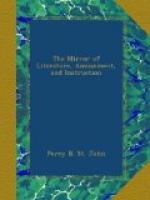* * * * *
LEE, KENT.
The rural village of Lee is situate six miles south of London, on the south side of Blackheath, and on the road to Maidstone. It is a place of considerable antiquity; and was originally written Legheart, and in old Latin, Laga, i.e. a place which lies sheltered. “The manor was held of Edward the Confessor by Alwin. William the Conqueror gave it to his half-brother, Odo, bishop of Baieux, and Earl of Kent, of whom it was held by Walter de Donay.” In the time of the Confessor, it was valued at 3_l._ and in Domesday at 100_s_. Its extent is somewhat more than 1,000 acres. Hasted enumerates the successive lords, among whom were Lord Rivers, who was beheaded at Banbury in 1649; and his son, Anthony, Earl Rivers, who was beheaded at Pomfret, in 1483. The manor was purchased by Sir Francis Baring, bart., in 1798.
* * * * *
[Illustration: Lee Church and Parsonage.]
* * * * *
The picturesque vignette includes the church and parsonage. The Church is in what is called the pointed style, or rather in humble imitation of antiquity, for it is a recent structure built on the site of the walls of the old church, but with the addition of side-aisles. Nearly two centuries before the erection of the present church, the villagers reported the old building to be in a state too ruinous to admit of repair: how long did its stability gainsay their judgment, while they were laid asleep about the walls. The church was an appendage to the manor till the time of Charles I., who granted away the fee of the manor, but reserved the patronage of the church to the crown, where it continues to this time. It was valued l5 Edward I. at 10 marks; in the king’s books it is at 3_l._ 11s. 8d.; and the yearly tenths at 7s. 2_d_. The parsonage has much of the snug character of the glebe-house; it was rebuilt in 1636, by the rector, the Rev. Abraham Sherman.




